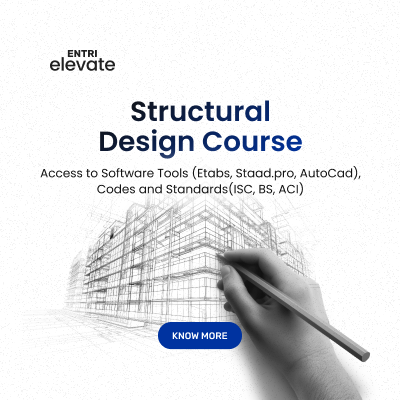Table of Contents
Working as a structural designer gives you the chance to solve real-world architectural problems creatively. Structural designers prioritize safety, material lifespan, and building aesthetics in addition to building design principles. Gaining knowledge about structural design might assist you in determining whether this is a suitable career path for you. In this post, we’ll talk about what a structural designer is, what they do, and how to become one. We will also answer the question “How to Learn Structural Design?”.
How to Learn Structural Design: Introduction
Structural engineering is a branch of civil engineering that focuses on the strength, stability, and durability of buildings, bridges, aircraft, and other structures. To create a comprehensive and secure structure, structural engineers collaborate with architects and designers, applying their understanding of physics, mathematics, and structural design parameters. Since geological limitations, environmental difficulties, and soil kinds may affect the entire construction process, no two constructions are precisely the same. The secret to becoming a successful structural engineer is knowing how these components interact.
Because structural engineering requires a deep comprehension of physics, mathematics, and materials science, it is both fascinating and difficult. Designing and assessing structures as a structural engineer requires the use of intricate mathematical formulas and advanced computing applications. Since you will be working on projects with a variety of experts, including architects, contractors, and other project stakeholders, practical communication skills are just as important as technical competence.
You may currently be an engineering student, a recent graduate of structural engineering, or you may be working as an architect, professional engineer, or project manager, among other related occupations. Some of this blog article could be obvious, while others might not be what you expected.
Key Concepts in Structural Design
1: What is the primary purpose of structural design?
Strong knowledge in a variety of subjects, including structural analysis, material mechanics, earthquake engineering, and structural dynamics of water systems, is necessary to succeed as a structural engineer. Understanding the behaviour and characteristics of typical structural materials, such as concrete, steel, and wood, under various loads and environmental circumstances is also crucial. Before delving fully into the more complex aspects, you must grasp certain fundamental structural design ideas. You will have difficulties in the future if you don’t learn these. Let us go through important key concepts.
Stress and Strain
Those who wish to become structural engineers must have deep knowledge of the principles of stress and strain. Similar to a push on anything, focus is quantified by the force applied to each region. When pressure causes a substance to alter form, this is known as strain. It is easier to break some materials than others. When choosing construction materials for structures like buildings and bridges, structural engineers use this knowledge. When construction materials are being utilized, they make sure the structure can withstand all the stress that it will experience. Additionally, they use materials that can withstand a lot of strain and stress.
Draw Correct Free-Body Diagrams
The ability to draw free-body diagrams is crucial for engineers. These diagrams display the forces operating on a structure as well as the inside of the structure. We can determine whether our system will be robust enough to endure all forces by removing these diagrams. Furthermore, free body diagrams assist us in forecasting a system’s behaviour under various circumstances and identifying areas in which it may require further support. Regardless of the complexity of the structures, they can always be reduced to a statically determinate free body chart. Whenever possible, engineers will simplify things.
It would be difficult to build dependable and safe structures for the sea environment without the capacity to create precise free-body diagrams. For structural engineers, free-body diagrams are necessary. They assist engineers in comprehending the forces at play while constructing a structure, designing the system to withstand those forces, and forecasting how the system will function in the event of a change. As a result, every engineer should become proficient in creating correct free-body diagrams.
Get the best mentors to learn structural engineering from! Join Entri Elevate today!
Identify The Correct Load Path
One crucial skill is being able to quickly figure out a structure’s proper load path into its foundations. Understanding how forces flow through a structure is a critical skill for structural engineers. It’s similar to Jenga, except that you don’t take any pieces away. This aids in ensuring the stability and safety of the system. It’s similar to completing a puzzle, but if we make a mistake, the consequences might be worse than losing a piece.
For instance, we must consider several factors, such as the amount of load and the components of new constructions, in order to ascertain how the load is transferred through a structure. It’s similar to being a detective, only instead of solving crimes, they’re attempting to understand the dynamics of forces. It is the responsibility of a structural engineer to determine the load paths. Their knowledge should enable them to ensure the safety and security of the structures they create.
Deformation and Deflection
Engineers must understand deformation and deflection. Deformation occurs when a substance undergoes a change in shape due to force, such as when a spoon is bent. A structure’s deflection is the amount of movement it experiences under pressure. Deformation and deflection are critical concepts for structural engineers to understand. The safety of a structure or bridge can be impacted by deformation and deflection. When designing a building, engineers utilize computers and calculations to determine if the construction will be strong enough. To make sure it won’t fall apart, they consider factors including the material, the location of the weight, and the kind of support.
Ensuring bridges and other infrastructure can support the weight of vehicles and people is crucial. It is the responsibility of structural engineers to provide safe designs. It is important that we conduct the calculations correctly to avoid any negative outcomes. Deformation and deflection are hence serious issues for civil engineers.
Equilibrium
The concept of equilibrium is fundamental to structural engineering. This implies that a structure has to have a balance between all of its forces. This helps engineers identify the forces operating on a system and make sure they are uniform. This is particularly crucial for beams and columns since an unbalanced point might cause them to crack or collapse.
Transform Your Career with Our Structural Design Course!
Unlock Your Potential in Structural Design! Gain expert knowledge in designing robust structures and advance your career in the construction and engineering fields. Limited spots available! 🌟
Know MoreMethods to Learn Structural Design
“How to Learn Structural Design?”. This must be a question that is now going on in your mind. There are many ways in which you can learn structural engineering. The first thing you have to do is complete your school education. Then you can focus on doing your bachelor’s in a subject relevant to structural engineering. This could be mechanical engineering, civil engineering, architecture, design etc.
Then you can turn to sources that solely focus on structural engineering. You can think about taking an online course if you’re an amateur who wants to master the fundamentals of structural engineering. You may learn the fundamentals of structural engineering at home using a variety of methods. But it’s crucial to do your homework and pick a reliable course that addresses the subjects you’re interested in. Above all, it enables you to have a solid understanding of the foundations before moving on to more complex topics like moment redistribution, virtual work, or indeterminate structures.
Where can we find a reliable course in structural engineering? Entri Elevate platform is providing a Structural Design course that suits all your needs. Take the NSDC-certified Entri Elevate Structural Design Online Course to learn structural design principles with knowledgeable instruction and practical experience. Entri Elevate Structural Design Online Course provides many features for its students. Some of them are listed below.
- Expert Guidance
- Live workshops by leaders
- Assignments
- Software skills (ETABS, STAAD pro, AutoCAD)
- Live Projects from the Middle East
- 12 months Mentorship
- Placement assistance
- CV preparation sessions
- Recorded classes
- Live doubt-clearing sessions
- Industry Interactions
- Course completion certificate
Click here to get more information about the Entri Elevate Structural Design Online Course!
Experience After Education
Gaining experience in positions associated with your major might support your career as a structural designer. Becoming a model designer while studying design might help you become ready for blueprint and structural analyses. You may learn how to create designs and how projects might change over time by taking design classes and working in the field. Many structural designers may have worked as architect drafters or mechanical designers in the past.
Learn structural design from industrial experts! Join Entri Elevate Structural Design Online Course!
How to Learn Structural Design: Conclusion
Understanding key structural engineering principles is crucial for structural engineers. These ideas aid in the design of buildings and allow you to examine basic constructions such as beams, frames, and columns. Entri Elevate Structural Design Online Course will help you on your path to becoming a successful structural engineer.
|
Engineering Upskilling Courses
|
| MEP Course |
| BIM Course |
| Structural Design Course |
| Oil and Gas Course |
Transform Your Career with Our Structural Design Course!
Unlock Your Potential in Structural Design! Gain expert knowledge in designing robust structures and advance your career in the construction and engineering fields. Limited spots available! 🌟
Know MoreFrequently Asked Questions
What is meant by a load path?
A load path is a pathway that loads or forces take through a building. Because they assist in establishing a structure’s overall stability and how it will react to various loading circumstances, load pathways are crucial in structural engineering projects. An effective load route should be able to disperse forces uniformly across a system, guaranteeing that no section of the structure will be impacted.
What are structural engineering fundamentals?
An outline of the fundamentals of structural engineering is given in this article. When constructing or researching structures like beams, frames, and columns, it describes how engineers must have a solid knowledge of topics like equilibrium, stress and strain, deformation and deflection, and load paths.
Describe earthquake engineering.
Earthquake engineering is a crucial area of study for structural engineers. The study of earthquake engineering examines how buildings react to ground vibrations or seismic forces. With this information, engineers may create structures and other infrastructure that can survive powerful earthquakes. This entails developing new systems that satisfy these requirements as well as assessing and modifying current systems to increase their seismic activity resistance.
What do live loads and dead loads mean?
The weight of a structure’s components and any permanent fixtures or equipment are examples of dead loads, which are static forces operating on a structure. Dynamic forces including wind, snow, and passengers are known as live loads. Because both dead and active loads contribute from distinct members to the system’s overall load route, they must be taken into account while constructing a structure.
What is the definition of structural analysis?
Understanding how a structure responds to different loading scenarios is known as structural analysis. It entails simulating a structure’s reaction to various stresses using mathematical formulas and physical concepts. Many uses for structural analysis include building new systems and structures, assessing the stability and safety of current systems, and forecasting how they will behave in severe or unexpected situations.
What is meant by structural dynamics?
As a structural engineer, it is crucial to comprehend structural dynamics. The study of how structures behave over time under various force and loading scenarios is known as structural dynamics. It focuses on the response of systems under dynamic stressors, such as wind or earthquakes. Engineers may create more robust and long-lasting systems that can tolerate dynamic forces with the aid of this kind of analysis.
What is structural engineering?
Structural engineering is the study and practice of civil engineering, which primarily consists of designing and constructing safe, sturdy, and robust structures. In order to develop designs that minimize failure risk while optimizing efficiency, it entails comprehending fundamental concepts such as equilibrium, stress and strain, deformation and deflection, load pathways, and frames. Existing structures are also inspected by structural experts to make sure they adhere to safety regulations.
Which materials are frequently utilized in structural engineering?
In structural engineering, steel-reinforced concrete, composite, timber, and reinforced concrete are often utilized materials. Steel is the main material used for bridges, buildings, and other high-rise constructions because of its strength and endurance. Because concrete is robust enough to support weight, it is frequently used for walls and foundations.














